December 13-20, 2022
Lake Cahuilla Veterans Regional Park
Located in close proximity to La Quinta, Coachella and Palm Springs in Southern California, Lake Cahuilla (pronounced: ka-WEE-yah) Veterans Regional Park is a great camping destination for those looking for a peaceful location away from the bustle of the city. The 710 acre park offers lakeside camping (yes, lakeside in the desert!) with expansive views of the Santa Rosa Mountains. The tidy and well-maintained park is owned by the Coachella Valley Water District and operated by Riverside County Parks. We spent eight nights there in mid-December on our way from Joshua Tree National Park to Anza-Borrego State Park.
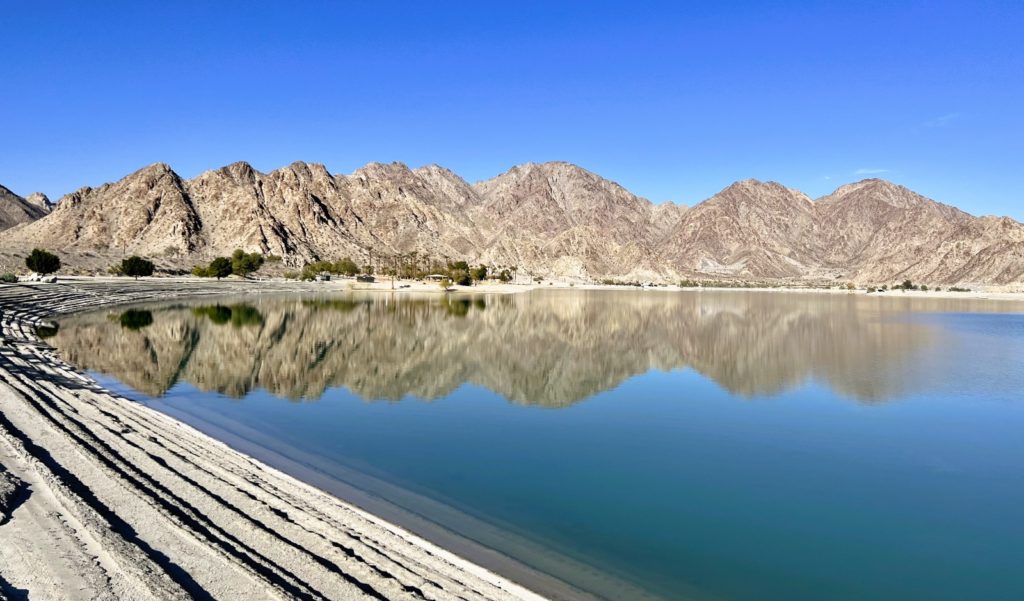
With thousands of farm acres, resorts, golf courses, and commercial and residential growth, the Coachella Valley’s massive water needs are met by groundwater and imported water from the Colorado River. The imported water is a significant portion of the water supply and helps conserve groundwater supply. Lake Cahuilla was constructed in 1969 to store that water from the Colorado River. It takes water 24 hours to arrive in the Coachella Valley after being ‘ordered’ from the Imperial Dam. The lake is 3/4 of a mile long and half that wide at its widest point. Averaging 10 feet deep, it holds approximately 1,300 acre-feet of water (433.6 million gallons). Lake Cahuilla Veterans Regional Park is located along the southwest shore of the lake.


Lake Cahuilla Veterans Regional Park includes a campground, picnic facilities, sand volleyball, bocce ball, swimming pool (April – October), hiking/horseback trails and great fishing opportunities. Boating and swimming are not allowed in the lake. The well-maintained campground has 62 hookup sites with power and water (a couple also include sewer), 10 water only sites, 20 equestrian sites with horse corrals, and 35 primitive dry camping sites. All sites include table, grill, and fire ring. Restrooms, showers, and dump station are available.

Campsites are $25-45 per night. We had a beautiful waterfront site with one of the best views in the park. Our site included a picnic table, fire ring, grill, and water hookup for $30 a night. None of the waterfront sites have electric hookups, but that wasn’t a problem for us thanks to our solar panels. Max and Makala (our family from back home) needed an electric hookup, so we booked them a lakeview site a few spots down for $45 per night. The park has a very generous weekly rate that is almost half off the nightly rate, so stay a week if you can! Our 8 night stay cost $150 dollars after reservation fee and the weekly discount.

This was our first time visiting the Palm Springs/Coachella area and we had a long list of places we wanted to visit, but we only made it to a fraction of them. We didn’t even make it up to Palm Springs, but that’s just a great excuse to go back. We spent our two remaining days with Max and Makala making day trips to the Salton Sea and Borrego Springs. Another day was spent with family from L.A followed by a day of chores (laundry, propane refill, grocery resupply). We also made it up to the southern portion of Joshua Tree National Park then ended our stay with a couple of days lazing around the lake enjoying the sun, birds, and casual walks.




Overall, Lake Cahuilla was an affordable and hidden gem in an area of $100 per night RV resorts. If you are looking for a place close to the sites in Palm Springs, this isn’t the best option. But if you want clean, scenic, peaceful, and well-maintained by very nice staff, consider Lake Cahuilla. Our only real ding was the law enforcement shooting range on the far side of the lake. We did hear some ‘pops’, but it really wasn’t a big deal and didn’t detract from our stay. The noise wasn’t overwhelming and the hours of operation appeared to be very restricted.




Joshua Tree National Park: Lost Palm Oasis
Our basecamp at Lake Cahuilla was 20 minutes closer to the southern entrance into Joshua Tree National Park than our previous campsite had been. The most popular sites in Joshua Tree are concentrated in the far northern section of the park. With the lion’s share of visitors flocking to that northern section, Cottonwood Spring area in the south is a quiet and peaceful hiking destination.

When most people think of Joshua Tree National Park, they picture a terrain dominated by Joshua trees and yuccas with massive granite monoliths and rock formations. But the southern portion of the park is actually quite different. It is more sparsely vegetated and is dominated by creosote bushes, ocotillo and cholla cactus and generally lacks the park’s namesake Joshua tree. The reason for this difference is that the massive park covers parts of two very different deserts, the Mojave and Sonoran, which divide the park into two distinct ecosystems. The southeastern portion of the park is Colorado Desert, a portion of the larger Sonoran Desert. It is lower, flatter and warmer than the Mojave. Most precipitation is blocked by the Peninsular Range resulting in a mere 2–3 inches of rain per year. Summer temperatures can exceed 120 degrees Fahrenheit.
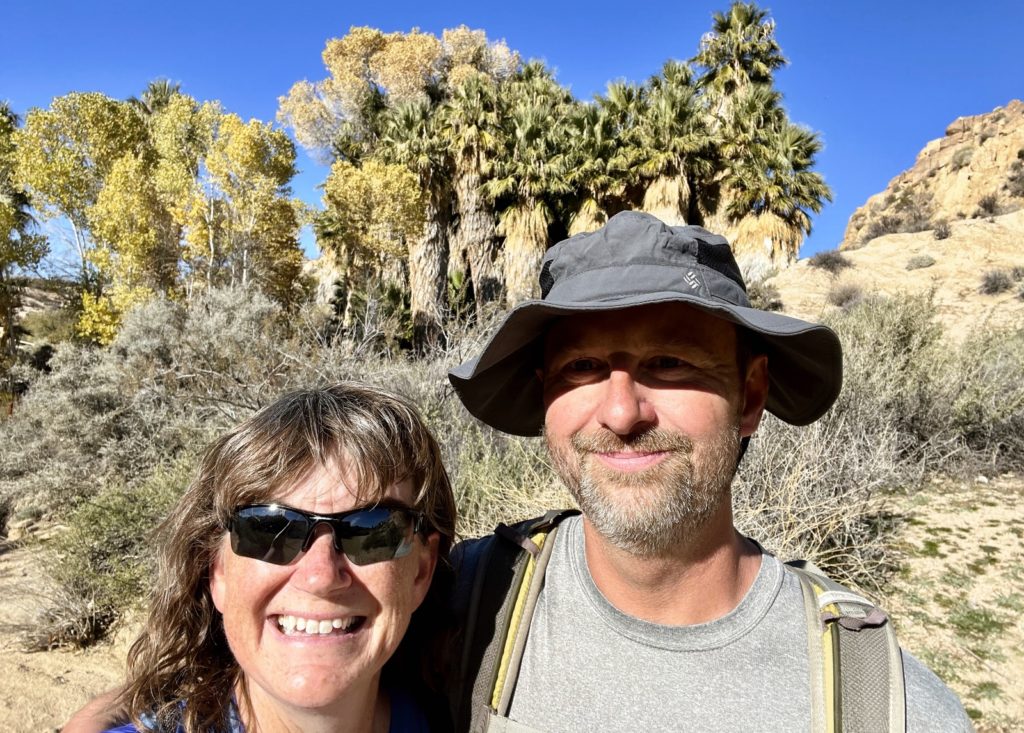
There aren’t a lot of hiking trails around Cottonwood Springs, but we wanted to spend at least one day in the area to check it out. The two most popular destinations are Mastodon Peak and Lost Palm Oasis. Lost Palm was the longer hike and we’re suckers for palm trees, so it was a pretty easy choice which trail to hike.

Lost Palms Oasis is located in the southeastern portion of Joshua Tree National Park. This oasis can be reached on a 7.5 mile out and back hike from Cottonwood Spring with 500 feet of elevation gain. The trail is on a mix of rock, dirt, and sandy washes with very little shade and includes a strenuous climb on rocky terrain out of the canyon that the oasis is located in at the far end of the trail. The oasis is located in Lost Palms Canyon where a permanent water source allows fan palms and other plants to thrive, supporting a vibrant desert wildlife community.
Joshua Tree National Park website

Our hike began at Cottonwood Spring which was a lovely starting point. Here, cottonwood and palm trees towered over the trail. The cottonwoods were sporting some fall colors (albeit a little on the dull side) which made for an interesting mix with the palms.




Past the spring, we immediately began seeing ocotillo cactus covered with beautiful green leaves. Typically, the ocotillo we see on our winter trips look like dead sticks. Their stems are leafless most of the time, but are covered with green leaves after a good soaking rain. The leaves remain on the plant until the soil dries out and then they fall off. Plants can grow and lose leaves four or five times in a year depending on rainfall. It was a real treat for us to see nearly every ocotillo leafed out thanks to the recent rains.




The trail was pretty easy for the first 2.0 miles. Overall, the scenery wasn’t spectacular, but it was lovely enough. At the 2.0 mile marker, things got more interesting as the trail turned rockier and we climbed and descended through washes and canyons and past some interesting boulder areas. At 3.5 miles, we reached the end of the official trail at an overlook into the canyon containing Lost Palm Oasis. You can continue down into the canyon to get a closer look at the palms, but there is no official trail and the terrain is steep and rocky. We satisfied ourselves with a nice break at the viewpoint. A couple other parties arrived while we were taking our break and they did the same.



Palm oases are an area of shade and life in an otherwise dry and unforgiving desert environment. They require a constant supply of water so they are often found along fault lines where uplifted layers of hard impermeable rock forces underground water to the surface. The water source also draws animals such as bighorn sheep, Gambel’s quail, and coyotes. There are only 158 desert fan palm oases in North America. Five of those are located in Joshua Tree National Park.


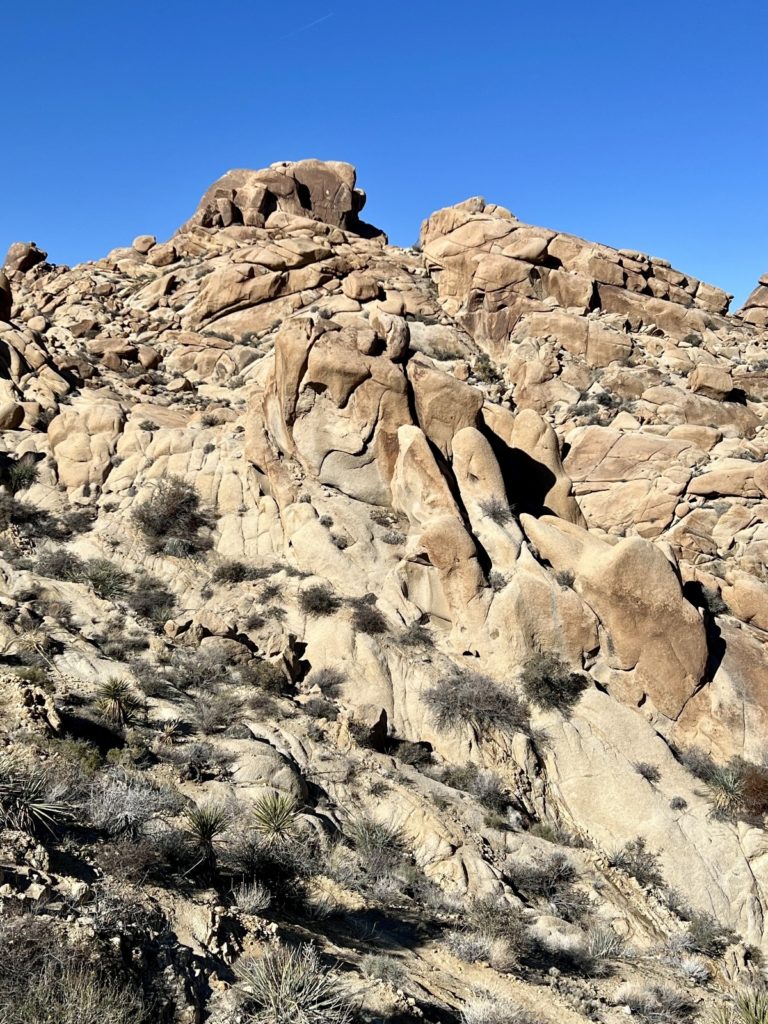

The desert fan palm is native to the low, hot deserts of southern California, where it can live for 80 to 90 years and grow up to 75 feet tall. Its leaves are shaped like a fan and folded like an accordion. They measure up to six feet in length and almost as wide. The fan palm’s dead leaves remain attached to its trunk until removed by fire, wind, or flood.
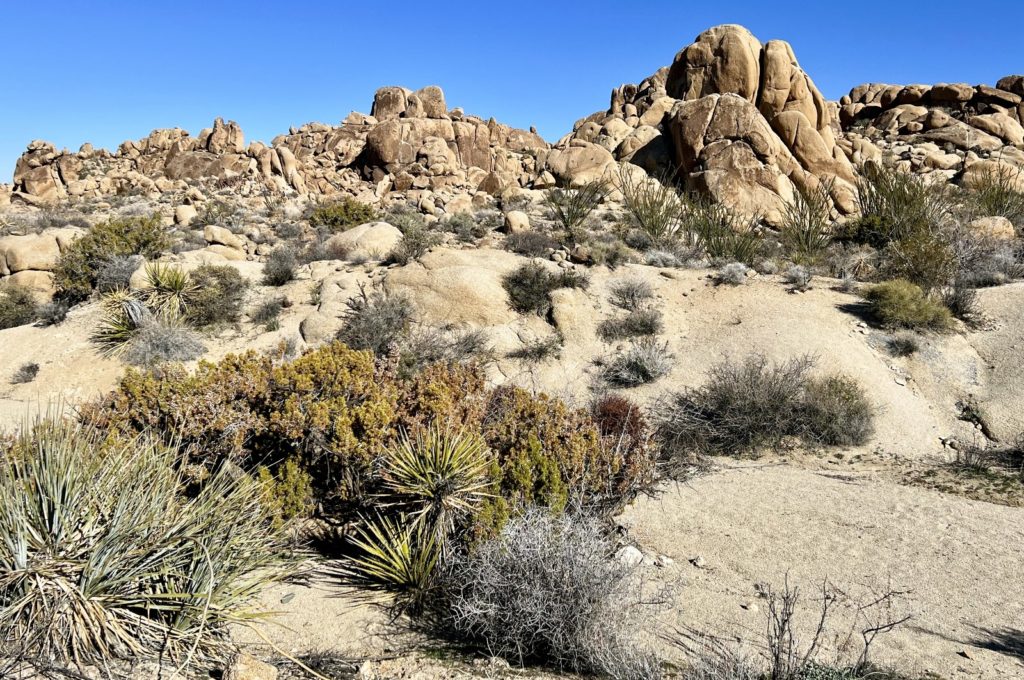

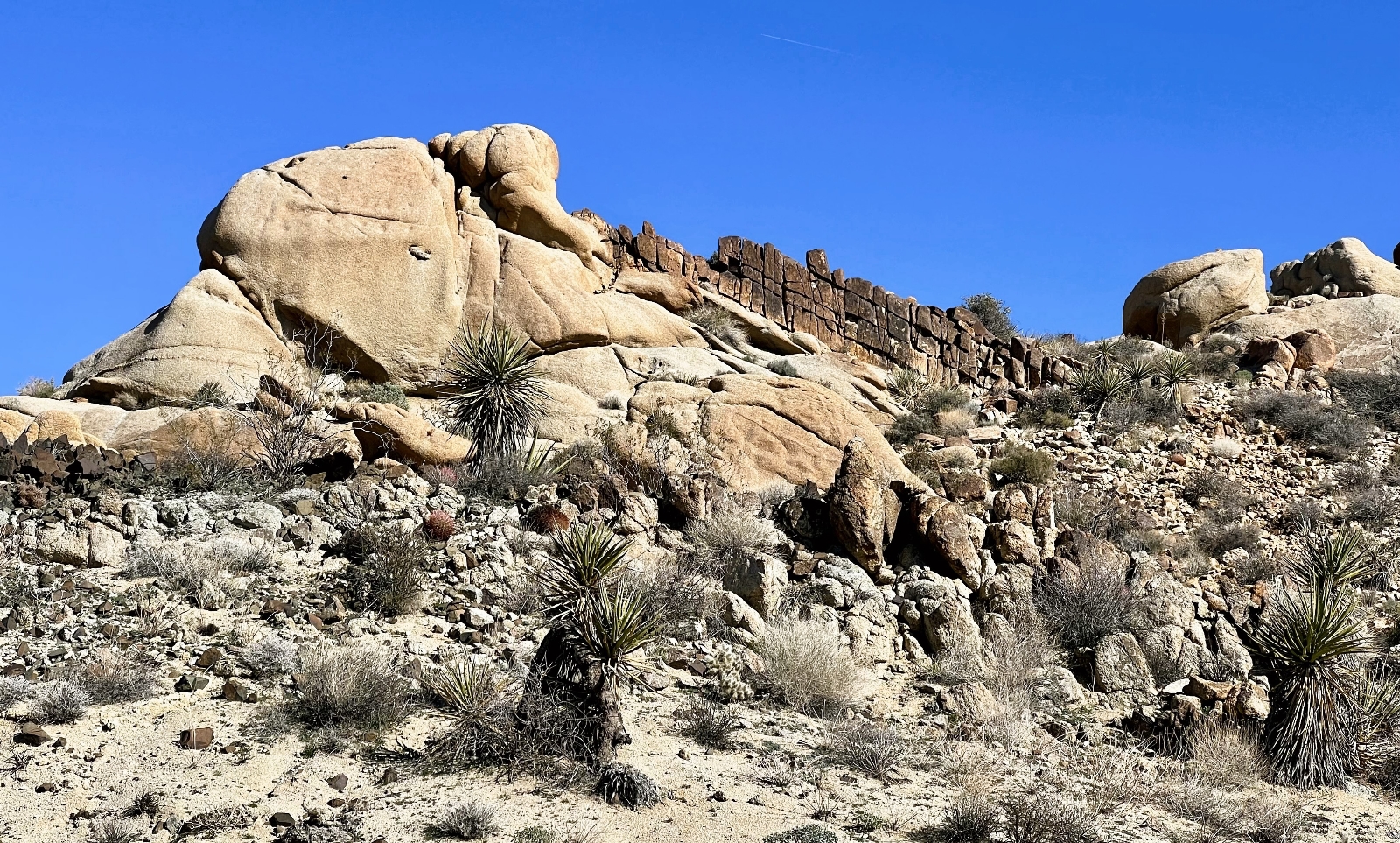
While we missed seeing the park’s iconic Joshua trees, we really enjoyed this hike and would recommend it to anyone looking for a fun adventure in the southern portion of Joshua Tree National Park.


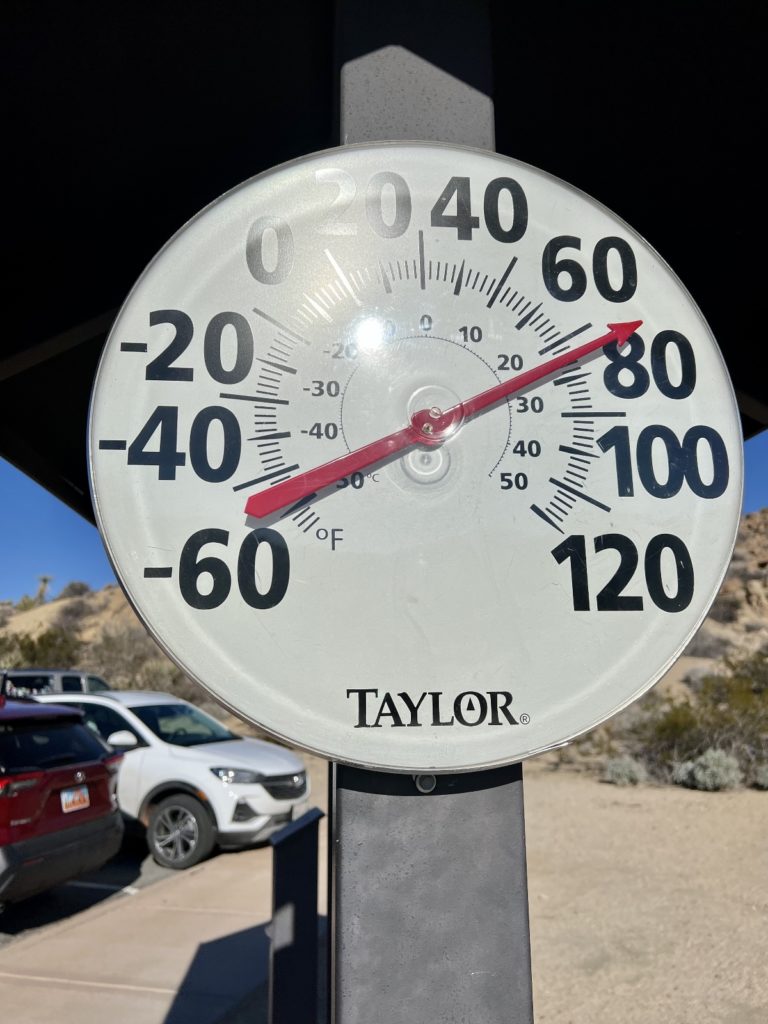
Related Posts
- Our Joshua Tree National Park Adventures Begin
- Joshua Tree National Park: Keys Desert Queen Ranch Tour
- Joshua Tree National Park: Black Rock Canyon-Panorama Loop
- Joshua Tree National Park: Barker Dam & Wall Street Mill
- Joshua Tree National Park: Willow Hole
- Joshua Tree National Park: Skull Rock-Split Rock Loop In the Snow!
- Our Return Trip Home Begins With a Layover at Joshua Tree
The Adventure Continues
Join us for our next post as we continue south to Anza-Borrego Desert State Park and the charming desert community of Borrego Springs for Christmas and New Years. And don’t forget to check out our Amazon RV and Adventure Gear recommendations. We only post products that we use and that meet the Evans Outdoor Adventures seal of approval. By accessing Amazon through our links and making any purchase (even things as simple as toothpaste!), you get Amazon’s every day low pricing and they share a little with us. This helps us maintain this website and is much appreciated!
